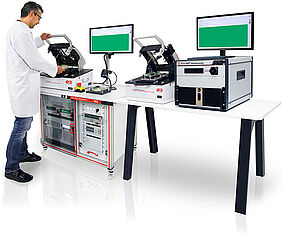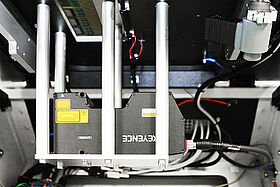Test system checks control devices under 500-V

Preferable lossless conversion of electricity into heat is one of the most important topics for the electromobility in the automotive industry. Because regular heating systems cannot be operated by waste heat in electrical and hybrid concepts, technologies had to be developed for this case.
With the systems of MCD Elektronik, control boards of heating modules are tested functionally and surveyed to achieve a permanent operational efficiency of up to 95 percent. Simultaneously, these boards control the battery management. It adheres the operating temperature of the car battery on a permanent level to prevent the sensitivity of the cold temperature conditions.
The End-of-Line test system, that is modularly built by VTS standard, tests the functionality of the PCBs (printed circuit boards) with circuit processes up to 500 volts. This corresponds to the power of the high-voltage electricity system of automobiles. Furthermore, operating elements and switches are implemented to the center console to control the thermo system of the vehicle and communicate with the control board via LIN protocol. The MCD developed LIN-CAN-Remote module simulates the circuits of the operating elements continuously because they are not yet connected during manufacturing procedures. Moreover, the EOLT simulates the communication with the heating elements to verify a lossless power transfer of 7 kW maximum.
 To prevent power losses, the position of insulated gate bipolar transistors, shortly "IGBTs", needs to be measured exactly. Only an exact positioning of soldered IGBTs allows an integrated contacting of cooling surface during later obstruction. The second test system covers this measurement via an integrated Keyence laser profiler. This sensor measures and detects wrongly positioned elements with an accuracy of 0,005 mm before obstruction. If this would not be ensured, a non-dissipated power loss would cause a destruction of the modules and a heating system breaks down.
To prevent power losses, the position of insulated gate bipolar transistors, shortly "IGBTs", needs to be measured exactly. Only an exact positioning of soldered IGBTs allows an integrated contacting of cooling surface during later obstruction. The second test system covers this measurement via an integrated Keyence laser profiler. This sensor measures and detects wrongly positioned elements with an accuracy of 0,005 mm before obstruction. If this would not be ensured, a non-dissipated power loss would cause a destruction of the modules and a heating system breaks down.
Sebastian Faaß from MCD's Hardware Application Team said: "There are many high voltage safety installations integrated into the test adaptions because of the high voltages, that are used for connecting car batteries and heating systems with the vehicles architecture. To protect the engineers during the assembly process as well as the operative personnel during production, many security mechanisms had to be integrated. It must be guaranteed at all times that there are no active circuit operations with 500-V if doors or adapter covers are open. All of the locking mechanisms are secured by contact fuses, these are linked together by a certified security system. If a locking function is inactive or a potential operating error exists, the test process cannot be performed."